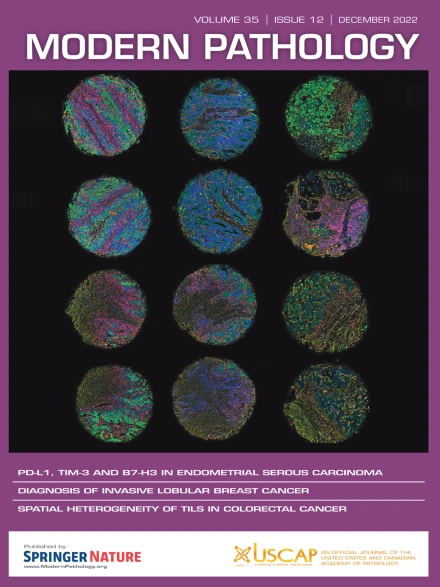HER2, HER3, and Mismatch Repair Protein Expression in Stage IV Small Bowel Adenocarcinoma: Results From a Multicenter Series
IF 7.1
1区 医学
Q1 PATHOLOGY
引用次数: 0
Abstract
Small bowel adenocarcinoma (SBA) is a rare and aggressive malignancy. One-third of SBA cases are diagnosed at an advanced stage, often with limited treatment options. Recent clinical trials have underscored the importance of testing predictive biomarkers for therapy response in advanced solid tumors, particularly with respect to antibody-drug conjugates and immunotherapy. However, few studies have investigated the expression of mismatch repair (MMR) proteins, HER2, and HER3 in metastatic SBA. In this study, the immunohistochemical expression of MMR proteins, HER2 (using gastric cancer scoring criteria), and HER3 was assessed in a multicentric series of 26 stage IV SBAs. In 7 cases, tissues from both the primary tumor and paired distant metastasis were tested for all biomarkers, and any discordance in biomarker expression (ie, spatial heterogeneity) was recorded. For comparison, a cohort of 47 stage III SBA patients was also evaluated.
MMR deficiency (MMRd), HER2 positivity (score 3+ or 2+ with gene amplification), and HER3 positivity were identified in 11.5%, 7.7%, and 40% of stage IV SBAs, respectively, with limited overlap among the biomarkers. One stage IV SBA showed heterogeneous MMR status, with a distinct subclone lacking MSH6 expression. When stage III SBAs were compared with stage IV SBAs, MMRd was more frequent (31.9%) among stage III SBAs. In 1 case (14%), the primary tumor was MMR-proficient, HER2-negative, and HER3-negative, whereas the metachronous distant metastasis was MMR-deficient, HER2-negative, and HER3-positive. The percentage of MMRd and HER2 positivity observed in stage IV SBAs highlights the need to assess HER2 and MMR status in these rare tumors. Our findings also suggest that evaluating the response of SBAs to anti-HER3 therapies should be considered in future clinical trials. Additionally, evidence of spatial heterogeneity in biomarker expression emphasizes the importance of assessing biomarkers in metastatic tissue to identify actionable alterations that may not be present in the primary tumor.
HER2, HER3和错配修复蛋白在IV期小肠腺癌中的表达:来自多中心系列的结果
摘要小肠腺癌是一种罕见且具侵袭性的恶性肿瘤。三分之一的SBA病例在晚期被诊断出来,通常治疗选择有限。最近的临床试验强调了检测晚期实体瘤治疗反应的预测性生物标志物的重要性,特别是在抗体-药物偶联物和免疫治疗方面。然而,很少有研究调查错配修复(MMR)蛋白、HER2和HER3在转移性SBA中的表达。在这项研究中,在多中心的26例IV期SBAs中评估了MMR蛋白、HER2(使用胃癌评分标准)和HER3的免疫组织化学表达。在7例病例中,对原发肿瘤和配对的远处转移的组织进行了所有生物标志物的检测,并记录了生物标志物表达的任何不一致(即空间异质性)。为了进行比较,还对47例III期SBA患者进行了评估。MMR缺陷(MMRd)、her2阳性(基因扩增评分为3+或2+)和her3阳性分别在11.5%、7.7%和40%的IV期SBAs中被鉴定出来,生物标志物之间的重叠有限。一个IV期SBA表现出异质MMR状态,具有不同的亚克隆缺乏MSH6表达。当III期SBAs与IV期SBAs比较时,MMRd在III期SBAs中更常见(31.9%)。在一例(14%)中,原发肿瘤为mmr正常、her2阴性和her3阴性,而异时远端转移为mmr缺陷、her2阴性和her3阳性。在IV期SBAs中观察到的MMRd和HER2阳性百分比强调了评估这些罕见肿瘤中HER2和MMR状态的必要性。我们的研究结果还表明,在未来的临床试验中应考虑评估SBAs对抗her3治疗的反应。此外,生物标志物表达的空间异质性的证据强调了评估转移组织中生物标志物以识别原发肿瘤中可能不存在的可操作改变的重要性。
本文章由计算机程序翻译,如有差异,请以英文原文为准。
求助全文
约1分钟内获得全文
求助全文
来源期刊

Modern Pathology
医学-病理学
CiteScore
14.30
自引率
2.70%
发文量
174
审稿时长
18 days
期刊介绍:
Modern Pathology, an international journal under the ownership of The United States & Canadian Academy of Pathology (USCAP), serves as an authoritative platform for publishing top-tier clinical and translational research studies in pathology.
Original manuscripts are the primary focus of Modern Pathology, complemented by impactful editorials, reviews, and practice guidelines covering all facets of precision diagnostics in human pathology. The journal's scope includes advancements in molecular diagnostics and genomic classifications of diseases, breakthroughs in immune-oncology, computational science, applied bioinformatics, and digital pathology.
 求助内容:
求助内容: 应助结果提醒方式:
应助结果提醒方式:


